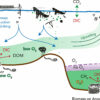Earth is a dynamic and constantly changing planet. From the formation of mountains and oceans to the eruption of volcanoes, the surface of our planet is in a constant state of flux. At the heart of these changes lies the powerful force of plate tectonics—the movements of Earth’s crustal plates. This fundamental process has shaped the current topography of our planet and continues to play a role in its future.
But what was plate tectonic activity like during early Earth? And was the process even occurring during the time when life is thought to have formed?
“The dynamic tectonic nature of the modern Earth is one of the reasons why life exists today,” says Wriju Chowdhury, a postdoctoral research associate in the lab of Dustin Trail, an associate professor of Earth and environmental sciences at the University of Rochester. “Exploring the geodynamics and the lithological diversity of the early Earth could lead to revelations of how life first began on our planet.”
Chowdhury is the first author of a paper published in Nature Communications that outlines how Rochester researchers used small zircon crystals to unlock information about magmas and plate tectonic activity in early Earth. The research provides chemical evidence that plate tectonics was most likely occurring more than 4.2 billion years ago when life is thought to have first formed on our planet. This finding could prove beneficial in the search for life on other planets.
Plate tectonics power the creation and destruction of Earth’s crust
Plate tectonics on modern Earth is “extremely important,” Trail says, because it is “the dominant mechanism for the creation and destruction of Earth’s crust.”
Earth is the only known planet that has a mobile upper crust that is cyclically destroyed and created. The process delivers critical elements, such as iron and magnesium, from the interior of the Earth to its surface and controls Earth’s water and carbon cycles. But, more importantly to geologists, plate tectonics melts and mixes rocks to create magmas with specific chemical makeups, depending on the rocks involved and the location where the “destruction” occurred. The chemical makeup of magma can therefore indicate the style of tectonics that created it.

Calculated SiO2 wt% of modeled Jack Hills zircons’ parent melts (n = 77) against zircon 207Pb-206Pb age. © Nature Communications (2023). DOI: 10.1038/s41467-023-36538-5
Ancient crystals as tiny time capsules
Chowdhury and his colleagues conducted their research using zircons—tiny crystals in rocks that are like small time capsules. The zircons contain trace amounts of chemical elements, locked into the crystals at the time when the crystals were formed. The researchers date the zircons and then work backward, with zircons revealing information about the chemical makeup of the parent magmas from which the zircons crystallized. Researchers then use information about the magmas to reconstruct the physical and chemical environment—and to infer plate tectonic styles—of the early Earth, during the time when the zircons formed. In this case, the zircons were around 3.8 to 4.2 billion years old.
According to Chowdhury, most researchers infer information about early Earth using zircons to create probabilistic models to present different tectonic scenarios. Chowdhury and his colleagues went a step further to describe not only the zircons but also the parent magmas.
“Parent magmas are much more direct and reliable because they are closer to the source—the actual tectonic style,” Chowdhury says. “Our study describes the silicon and oxygen isotopic content of the zircons and the trace element content of the parental magmas, which has not been combined and presented before.”
Chowdhury, Trail, and their colleagues found chemical similarities between early Earth magmas and modern magmas created at tectonically active plate boundaries such as the Cascade and Aleutian Island chains or areas in Japan and the Andes Mountains.
“This suggests tectonic continuity from the ancient to modern times,” Trail says. “That is, our study shows the Earth, billions of years ago, might have operated similarly as it does today.”
A key characteristic of a habitable planet
The researchers did not determine whether life existed when plate tectonics began—”neither life nor tectonics have an accurate start date yet,” Chowdhury says, noting that the geology community is divided on these points. But the new data provides chemical evidence suggesting that plate tectonics could have been occurring more than 4.2 billion years ago.
Whatever the case, he continues, plate tectonics is a key reason why Earth currently has a temperate living environment—and could be an important factor in the search for habitable living environments on other planets.
“The chances for life to originate increase manifold if there is some planetary dynamism,” he says.
More information:
Wriju Chowdhury et al, Eoarchean and Hadean melts reveal arc-like trace element and isotopic signatures, Nature Communications (2023). DOI: 10.1038/s41467-023-36538-5
Provided by
University of Rochester
Citation:
Was plate tectonics occurring when life first formed on Earth? (2023, April 4)



